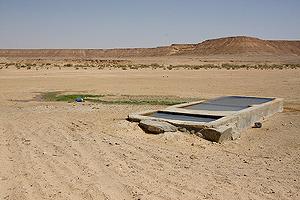 相較於地表的淡水,地下蓄水層的淡水含量足足多100倍,但儘管地下蓄水層對環境、社會、經濟和戰略等各方面都相當重要,卻是國際法一直以來所忽略的部分。
相較於地表的淡水,地下蓄水層的淡水含量足足多100倍,但儘管地下蓄水層對環境、社會、經濟和戰略等各方面都相當重要,卻是國際法一直以來所忽略的部分。
不過此情勢在上週有了變化。一份新國際條約草案20日提交到聯合國大會,該條約旨在保護這些跨國境的龐大地下水層。這份《跨區域地下蓄水層公約草案》(Convention on Transboundary Aquifers )擬適用於全球96%的淡水資源──也就是儲存在地下蓄水層的淡水,而其中大部分都跨越國界。
許多共用地下水層飽受氣候變遷、與日俱增的人口壓力、過度開發及人為造成的水汙染等環境威脅。因此,公約草案中要求共用地下水層的國家不要損壞現存的蓄水層,並共同合作來預防和控制汙染程度。聯合國國際法委員會過去花了6年的時間為公約做準備,期間也有來自聯合國教科文組織(UNESCO)國際水文計畫(International Hydrological Programme )的專家提供協助,目的就是要填補法律在這塊的缺失。
為了配合條約草稿,聯合國教科文組織破天荒首度發佈共用蓄水層的全球地圖,除了標出地下水層地點外,也提供水品質、降雨補充速度等資訊。
截至目前為止共有273筆共用地下水層的資料,其中68筆在美國、38筆在非洲、65筆在東歐、90筆在西歐以及在亞洲的12筆資料。
從1950年代以來,提升地下水的使用量補足了與日俱增的用水需求。以全球地下水使用來說,有65%用於灌溉、25%為飲用水,剩下10%則是提供工業使用。
歐盟國家使用的水源中,超過70%是來自於地下蓄水層;而在乾燥地區及半乾燥地區,地下蓄水層通常是唯一的水源供給處,像沙烏地阿拉伯和馬爾他100%都是使用地下蓄水層的水、突尼西亞則有95%,而摩洛哥是75%。
此外,某些國家的灌溉系統需大量仰賴地下水資源;仰賴比例分別為:利比亞90%、印度80%、南非84%及西班牙80%。
瓜拉尼地下蓄稅層是全球最大的蓄水層之一,面積蔓延1200萬平方公里,由巴西、阿根廷、巴拉圭及烏拉圭四個國家共同使用。
儘管每個州都擁有地下蓄水層系統,但並非全部都能藉由降雨規律性的補充。在北非及阿拉伯半島的地下蓄水層是在氣候較為潮濕的1萬年以前形成的,而之後蓄水層的水量就再也沒有補充過了。
就算一些區域內的蓄水層可繼續補充,仍會因為過度汲取或汙染而備受威脅。像在小島地區及地中海的海岸地區,人們使用地下水的速度通常比水源補充的速度還要快。
聯合國教科文組織表示:「非洲境內的地下蓄水層還未開發完全,且其中有些是全球最大的蓄水量…若以永續基礎來管理水源,那麼他們的潛力將無可限量。」
由於地下蓄水層通常橫跨好幾個國家,所以在非洲地下水資源的永續使用上,須仰賴一致的管理機制,以協助預防污染或是過度汲取。
伊萊梅登( IULLEMEDEN)地下蓄水層位於西非亞熱帶地區的稀樹草原生態區(savanna ecoregion),面積蔓延了50萬平方公里;針對伊萊梅登蓄水層管理系統,尼日、奈及利亞和馬利原則上已同意採取一套「諮詢機制」。對此,聯合國教科文組織表示:「該機制相當少見,但新公約有可能會促其成形。」
Underground aquifers contain 100 times the volume of fresh water found on the Earth's surface but they have been neglected under international law despite their environmental, social, economic and strategic importance.
On Monday, that will change as the UN General Assembly receives the draft of a new international treaty to safeguard these enormous pools of underground water shared by more than one country.
The draft Convention on Transboundary Aquifers applies to 96 percent of the planet's freshwater resources - those that are to be found in underground aquifers, most of which straddle national boundaries.
Many shared aquifers are under environmental threats caused by climate change, growing population pressure, over-exploitation, and human induced water pollution.
The draft treaty requires that aquifer states not harm existing aquifers and cooperate to prevent and control their pollution. Prepared over the past six years by the UN International Law Commission with the assistance of experts from UNESCO's International Hydrological Programme, the treaty is intended to fill a gap in the law.
To accompany the draft treaty, UNESCO is publishing the first-ever world map of shared aquifers. It shows the aquifer locations and provides information about the quality of their water and rate of replenishment by rainfall.
So far, the inventory includes 273 shared aquifers - 68 are in the Americas, 38 in Africa, 65 in eastern Europe, 90 in western Europe and 12 in Asia.
The growth in the demand for water since 1950 has been met by the increased use of underground resources. Globally, 65 percent of this water is devoted to irrigation, 25 percent to the supply of drinking water and 10 percent to industry.
Underground aquifers account for more than 70 percent of the water used in the European Union, and are often the only source of supply in arid and semi-arid zones.
Aquifers supply 100 percent of the water used in Saudi Arabia and Malta, 95 percent in Tunisia and 75 percent in Morocco.
Irrigation systems in many countries depend very largely on groundwater resources - 90 percent in the Libya, 89 percent in India, 84 percent in South Africa and 80 percent in Spain.
One of the largest aquifers in the world is the Guarani Aquifer, extending over 1.2 million square kilometers, shared by Brazil, Argentina, Paraguay and Uruguay.
Although aquifer systems exist in all continents, not all of them are fed on a regular basis by rainfall. Those in north Africa and the Arabian peninsula were formed more than 10,000 years ago when the climate was more humid and are no longer replenished.
In some regions, even if the aquifers are renewable, they may be endangered by over-exploitation or pollution. In the small islands and coastal zones of the Mediterranean, people often use groundwater more rapidly than it is replenished.
The aquifers in Africa, which are some of the biggest in the world, are still under-exploited, the UN agency says, adding, "They have considerable potential, provided that their resources are managed on a sustainable basis."
Since they generally extend across several national boundaries, the sustainable use of African aquifers depends on agreed management mechanisms that will help prevent pollution or over-exploitation.
In their project concerning the Iullemeden aquifer that extends over 500000 square kilometers in the semi-arid tropical savanna ecoregion of West Africa, Niger, Nigeria and Mali have approved in principle a consultative mechanism for administering the aquifer system. UNESCO says such mechanisms still are rare but the new treaty may encourage their formation.
全文及圖片詳見:ENS


